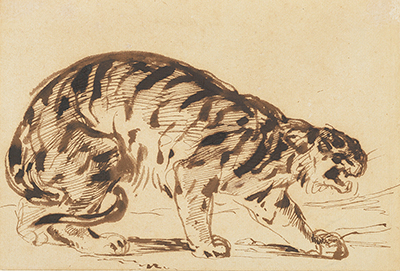Crouching Tiger is one of the most famous drawings completed by Eugene Delacroix and is dated 1839. The artist used ink and broader brush strokes for this piece.
The artist spent many hours studying the structure and behaviour of both lions and tigers in French zoos (most prominently in the menagerie at the Jardin des Plantes) for a number of years and would sometimes arrange personal visits prior to the arrival of the general public. He would also observe these beautiful creatures being fed as well and would later even sit in on a dissection in order to see inside and gain a more indepth knowledge of the muscle structure. He believed both animals had similarities to humans in many ways and he would use them in symbolic ways in many of his paintings. They were particularly suited to his work as an Orientalist artist, as shown in famous paintings such as Lion Hunt and Lion Rending Apart a Corpse.
Within this particular composition the tiger's back is arched as he appears to be preparing to pounce, in much the same way that any member of the large cat family would seek out its prey. Delacroix would clearly have worked in the main detail with pen first, before then making use of a wider brush to add definition and contrast to the piece. Also notice the tail that is wrapping around the tiger's back legs, almost like a snake preparing to strike.
This piece was the centerpiece for a recent Metropolitan Museum of Art exhibition which focused specifically on Delacroix drawings and drew on a number of pieces from the collection of Karen B. Cohen. She diligently collated a large number of his artworks over an extended period, from all manner of different sources. Whilst most are dispersed all around the world in a variety of public and private collections, her own selection is sufficiently broad to allow us to draw conclusions about his drawings just from this set of pieces alone. A publication which accompanied the exhibition has also helped to shed more light on his work in this medium.





